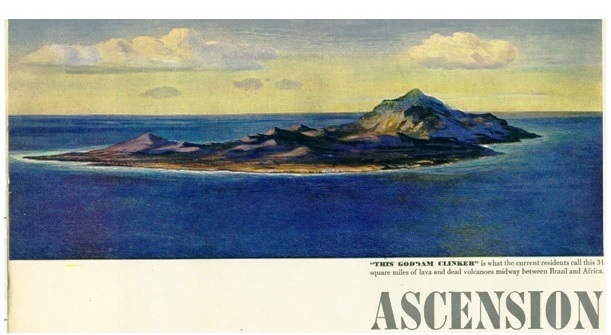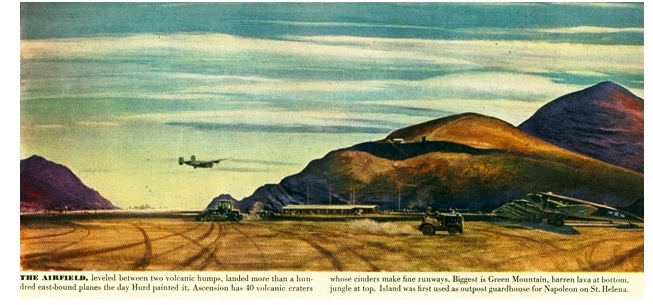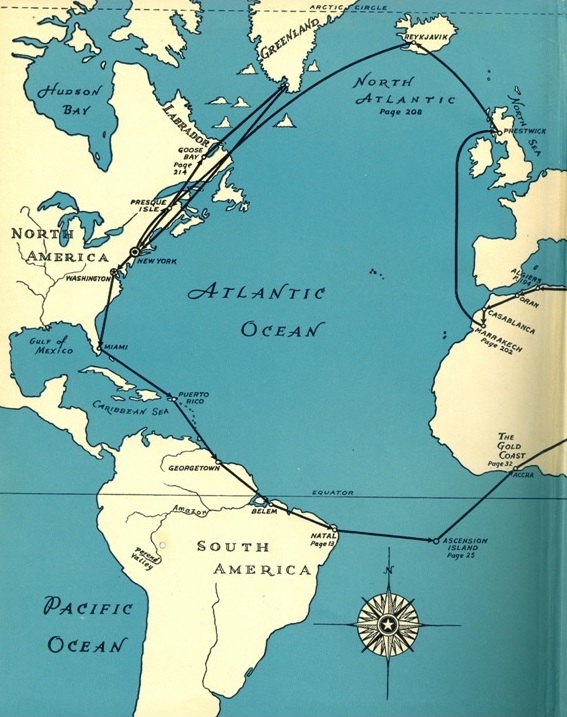Updated 7 November 2021
Research and story by Clarence Simonsen
That was the title in LIFE magazine for the 16 September 1941 issue describing the trade of 50 old American destroyers for control of the North Atlantic. President Roosevelt acted alone when he transferred the 50 warships to Britain and acquired a 99 year lease for eight U. S. air and naval bases from Newfoundland to British Guiana.
These first eight American bases would become the stepping stones for a new series of outpost air fields that would become dominant in transporting new American and Canadian built aircraft across the Atlantic to the war fronts. The northern route from Gander, Newfoundland, Goose Bay, Labrador, to Greenland, and Iceland, became the early staging routes to Scotland and England, but they became impossible in the Arctic winter months. That led to construction of a southern route from Miami, Florida, to Borinquen Field, Puerto Rico, then 1,058 miles to Georgetown, British Guiana, then landing at an airstrip carved out of the jungle near Belem, Brazil. The next flight was 1,000 miles to a malaria infested air strip at Natal, Brazil. Air crews could remain at this large base for up to 14 days, and their departure was shrouded in total secrecy. The Atlantic Ocean around Ascension Island was also patrolled by German U-Boats looking for the ferry aircraft, which flew at 5,000 feet when they began landing descent.
This map from the inside cover of 1944 book “Flight to Everywhere” details the north and south routes that transported man, material, and aircraft to the war in Europe and Africa. From 1942 to 1945, thousands of aircraft containing officers and men were lost in this remote part of the world. The most dangerous part of the journey became the 1,450 miles of flight over the Atlantic from Natal, Brazil, to a dot in the Ocean named Ascension Island. To avoid a navigational error, the fighter aircraft flew in groups of four, led by a C-87 Liberator transport carrying a navigator.
While the air crews enjoyed Natal’s beach, others drink beer [Cervesa] at the Grande Hotel. The Liberator Transport aircraft are loaded for the trip to Africa, while the P-38 fighters wait for a departure time. Note the extra fuel pods for the long 1,450 mile flight.


Images from 1944 book – Flight to Everywhere
LIFE war correspondent artist Peter Hurd painted Ascension in 1943.


Named for the Christian Holy Thursday, 39 days after Easter, and the bodily ascension of Jesus into heaven, this 34 square miles of barren lava rock was discovered by Portuguese navigator Joo Nova on Ascension day in 1501, but the worthless spot was not claimed or desired by any country. The island has no water supply, little rain fall, and the only vegetation grows high up on the only mountain top named “Green Mountain.” A small British naval force took the island without any opposition in 1815, and why the British wanted this rock “Clinker” is not fully understood. When the South Atlantic cable was laid the complete island was leased to the English communications firm, Cable and Wireless Ltd. It became a cable station and the lonesome island was home to seventy-five Britons who lived on the rock and were dependent on one ship a year bringing water, provisions, and a welcome replacement. The island is the most populated bird haven on the earth and if you like eggs cooked in any fashion, they are eatable.
The island was leased from the British in January 1942, and a detachment of American Army engineers arrived in March. In 91 days, they had blasted, bulldozed, and carved out a 6,700 foot landing strip. Then they constructed a barracks, mess hall, machine shop, and tents for the 2,000 U. S. Army Air Force staff that would live on this rock. The air base named “Wideawake”was in full operation by the Americans in September 1942.

The completed 1942 airport lava rock runway and the living conditions. Weekly water ration was five gallons per man.

Peter Hurd painting of runway in July 1943, when over one hundred aircraft arrived that single day. This was also the peak period for German U-boat attacks on the ship convoys approaching the Straits of Gibraltar.

Images from 1944 book Flight to Everywhere

American Colonel John C. Mullinex and British Governor Colonel J. N. Tomlinson supervise the remote base activities.
While the island remained the loneliest place Americans were serving, they are also called upon for hard work, with plenty of time to eat and sleep. The airport was one of the busiest with all food, thousands of tons of aviation fuel and boxes of spare parts flown in daily. The water purifying plant makes sea water fit to drink and each man is allowed five gallons per day.

While the island appears from the air to be heavily defended, the antiaircraft batteries are just dummy.
The real protection of Ascension has not been left to dummies or imitation guns. It is performed by a special group of pilots and aircrew who land on the island every day and take every precaution to prevent any surprise attack by enemy ship or submarine. The strategic importance of this rock island in delivering supplies and combat aircraft to Africa, year around, was the first priority. It also became a very special re-fueling point and rest stop for the newly formed 480th U.S. Army Air Forces Antisubmarine Group from 20 June 1943 until 29 January 1944.
This early 480th Group B-24D flew with Type 2 National Insignia, introduced 18 August 1942 until 29 June 1943. The aircraft number 15 was orange. Only the upper surface is Olive Drab, remainder is insignia white. This could be the first 480th Group B-24D to land on Ascension, May 1943.
On 8 December 1941, the U.S.A.A.F. First Air Force received new orders to begin overwater reconnaissance patrols looking for German U-Boats on the Atlantic coast of United States. This was a new style of war for the Americans and it would take time to form and learn new anti-submarine tactics. The First Air Force had been activated on 18 December 1940, to train new air force organizations and provide air defense for the eastern United States of America.
On 15 October 1942, the Army Air Forces Antisubmarine Command was activated, and a good portion of its tactics and techniques would be learned from the British at RAF Station St. Eval. RAF St. Eval was situated near Cornwall, England, with the primary role to provide anti-shipping and anti-submarine patrols off the south-west coast.
On 7 September 1942, Consolidated B-24D bombers from the 93rd Bomb Group, 409th Bomb Squadron, based at RAF Station Alconbury, were transferred to RAF St. Eval and the first American antisubmarine bomber training began. At this point many plans were being made in haste and with great secrecy.
Some of these B-24D Liberators came with the official 409th Squadron nose art emblem of a running Panda bear, carrying a white 500 pound aerial bomb. These standard B24D Liberator antisubmarine training aircraft and crews were returned to the 93rd Bomb Group on 6 December 1942, replaced by the new formed 1st Antisubmarine Squadron from Langley Field, Virginia, U.S., who arrived at St. Eval on 10 November 1942. The 2nd Antisubmarine Squadron from Langley arrived at St. Eval on 2 January 1943, and these two squadrons took over the first American operational submarine attack training. They arrived with new modified B-24D aircraft with radar and modern detection equipment.
These two American Army Antisubmarine squadrons began combat training on 15 January 1943, flying from RAF Station St. Eval on operational killer hunts against German U-boats in the Bay of Biscay. They were placed under command of Colonel Roberts, working as a detachment of the 25th Antisubmarine Wing. The 1st Squadron flew its first mission on 16 November 1942. The 2nd Squadron flew their first mission on 16 January 1943, exactly two months later. On 20 occasions the Americans sighted a German U-boat and in eleven instances the submarines were attacked. The squadrons encountered four German Ju-88 aircraft and two were damaged and possibly shot down. During training they lost 65 officers and men, with seven B-24D aircraft destroyed.
In late March 1943, the two squadrons were next reassigned to Port Lyautey, French Morocco, and on 19 June 1943 they became the 480th American Antisubmarine Group. They flew a modified B-24D Liberator bomber equipped with radar, external long range fuel tanks, and other special equipment for hunting German U-boats. Their new combat operating area was north and middle Atlantic from Newfoundland to Trinidad. The southern route was from the Bay of Biscay to Ascension Island, a major part of the Battle of the Atlantic.
The B-24Ds used by the 480th Group were initially painted in normal olive drab and grey camouflage with the serial number and radio call letter in yellow on the tail fin. With their arrival at Port Lyautey in June, the aircraft all received insignia white sprayed undersurfaces, which modellers call shade 46. This white was sprayed up the aircraft fuselage sides and some even painted the outer two vertical tail fins. Code single letters appear in white, while aircraft numbers on nose are yellow. No two aircraft appear to have the same white sprayed color markings, just a wave pattern.
On 10 May 1943, two B-24D aircraft were dispatched to Natal, Brazil, as an experimental detachment to protect Ascension Island. On 27th of May this detachment moved its ground echelon to Ascension Island, and the following month increased its B-24D strength to four aircraft. It is believed they were the 480th Antisubmarine Group men and aircraft. The following four nose art images were 480 Group B-24D aircraft, possibly taken on Ascension Island in August 1943.
Refueling a B-24D Liberator code letter “C” from the 480 Antisubmarine Group on Ascension Island 1943. The nose art appears to show a red devil with horns about to attack a nude lady floating on the surface of the ocean. The words are ‘EM DIVING, possibly for “keep them German U-Boats diving?” This could be one of four B-24D aircraft that were moved from Natal, Brazil, to Ascension Island on 27 June 1943.
It could also be one of the long-range B-24D aircraft that flew over one thousand miles from home base at Port Lyautey and then re-fueled at Ascension.
Another view of B-24D code letter “C” named ‘EM DIVING, showing eleven German submarine attacks. The months of July and August 1943, was the period when the most submarine attacks were made.
Impressive nude lady with double meaning nose art name. It appears the B-24D serial number has been painted over.
More B-24D nose art from the 480th Antisubmarine Group taken on Ascension Island. Note the long line of eleven German U-boat attacks painted as sub silhouettes. These appear in the same color order as those painted on “The Sad Sac” and I believe they were the total 480th Group German submarine and aircraft attacks, displayed on each B-24D.
This B-24D nose art reflected on the life style of Ascension Island. This image was taken on Ascension Island and it is possible this B-24D was one of those based on the rock 27 May 1943.
The Sad Sac was painted on both sides.
These B-24D aircraft carried the Type 3 U.S.A.A.F. National Insignia, introduced on 29 June 1943. This featured the new 2″ wide red band running around the complete national insignia. This shows in the photo with nose art name ‘EM DIVING.
After hours of long range patrol looking for German aircraft and U-boats, the Liberators crews would land at Ascension for fuel and a rest period. A normal long range flight covered over 1,000 miles of the Atlantic Ocean. Compared to their home base at Port Lyautey, French Morocco, the tent living conditions on Ascension were a hell hole. The nose art of the famous “Sad Sack” appeared on hundreds of WWII aircraft but this spelling of “SAC” referred to the poor aircrews who stayed on Ascension.
The WWII spelling of “SAC” was a common derogatory term to define the poor soldier as the skin that surrounds the male balls.
This photo image of “The Sad Sac” appeared in the 1944 book titled “Flight to Everywhere” by Jvan Dmitri. The photo was taken in August 1943 on Ascension Island, and records the white kill of three Fw 200C-1 long range convoy attack aircraft. The last kill was recorded on 17 August 1943.
The list of German submarine attacks only appears on the port [pilot] side of the B-24D bombers. The submarine silhouette was painted in three colors, white [possible surface day kills] yellow, [possible kill] and black for [under water kill].
The nose art marking on “The Sad Sac” clearly show three aircraft attacks in white, which appear to be German Focke-Wulf Fw 200C-1 Condor, identified by the large vertical gondola.

The Condor began patrols in mid-October 1943, providing target information for the German U-boats on Allied convoys leaving Gibraltar. They operated over a huge area from Gibraltar to the west coast of Africa, and made contact with 480th Antisubmarine Group B-24D aircraft on a number of occasions. The first came 18 July 1943, when Capt. Hugh Maxwell’s Liberator fired on a condor making a bomb run on a convoy. On 28 July 43, Lt. Elbert Hyde and crew chased a Condor which was attacking a straggler ship some fifteen miles behind the main convoy. The firefight took place as low as 30 feet off the water surface and the Condor plunged into the ocean. The next attack occurred in the same area west of Portugal on 31 July, when Capt. Gerald Mosier shot down a Condor that exploded when it struck the ocean. On 13 August 43, Lt. F. W. McKinnon damaged a Fw 200 which later crashed at El Ferrol, Spain, a claimed victory. On 17 August 43, Capt. Hugh Maxwell found two Fw 200 aircraft making bomb runs on a convoy and attacked. The two German aircraft then attacked the B-24D causing damage, and in the gun fight one Condor was shot down. The B-24D had to ditch and three crew members were pinned in the wreckage and died in the sinking. On 27 August 43, two more Condor aircraft were attacked by Capt. Maxwell but both eluded the Liberator in cloud cover. The last attack by the 480th came on 28 October 43, Lt. W. S. McDonnell chased a Condor into the clouds and it escaped.
It would appear the three Fw 200 Condor kills marked in white on the B-24D Liberators stood for the three kills – 28 July, 31 July and 17 August 1943.
“Off Limits” was the June 1943, Vargas pin-up in Esquire magazine. Photo taken Port Lyautey.
Another B-24D at Port Lyautey, showing a Beetle in flight.
The U.S. Army Air Force antisubmarine units were dispersed on the 28 October 1943, and their duties were slowly turned over to the United States Navy. The 480th Antisubmarine Group returned to Langley Field, Virginia, in November and they were disbanded on 29 January 1944.
Albert W. James collection taken at Langley Field, Virginia, November 1943.
“Old Bessie” was one of the veteran B-24D aircraft that won and survived the antisubmarine Battle of the Atlantic, then returned to the United States. The nose art image was the most famous 1936 Borden Milk company marking mascot named “Elsie the Cow.” In 1940, this American cow ranked very close to Santa Claus in popularity. From 1941-45 Elsie raised 1.6 million in war bond sales and remained a huge draw until the early 1970’s. She also flew with the 480th Antisubmarine Group as nose art.
Elsie the Cow at the New York World’s Fair 1939. [New York Public Liberty].
This proud Old Cow [Elsie] had done her part and was rewarded when the 480th Antisubmarine Group was presented with a Distinguished Unit Citation in 1944. How many German aircraft and U-boats did Bessie attack, and how many landings did she make on Ascension Island.
Today it’s hard to believe the U.S. Army Air Force pioneered the American attacks on German long range aircraft and U-boats, but that is the fact. Their unit combat action lasted only twelve months [10 November 1942 to 28 October 1943] and often they are forgotten in the war on German U-boats. It is also long forgotten that a little rock island named Ascension, played such a strategic part in winning World War Two.
This is dedicated to the Officers and men of the United States Army Air Force 480th Antisubmarine Group, the first sub-chasers.

























Reblogged this on Lest We Forget II and commented:
Another story by Clarence Simonsen
LikeLike
LikeLike
Hi,
My name is Edward L Hosack, do you have any more pictures of the B-24 Tidewater Tillie? My grand father was a door gunner on that aircraft. Thank you
Very Respectfully,
Edward L hosack
LikeLike
I found that image on the Internet. I don’t have any more.
LikeLike
LikeLike
http://www.uboatarchive.net/AAF/AAFAC-B24D.htm
LikeLike
LikeLike
LikeLike
I don’t know which I’d rather do – the ‘top’ or ‘bottom’ journey. Both are extremely perilous by the sounds of it and even the stopping off points weren’t hospitable.
LikeLike
I like Clarence’s research and stories. I always learn new things.
LikeLiked by 1 person
Pingback: Destroyers for Bases | My Forgotten Hobby
Where were you able to fund this information? My grandmothers first husband was in this squadron and died during a patrol. Would love to know more if you have anything else. It’s such a small part of the war that it always been difficult to find any information .
LikeLike
Give me more details like names, etc.
LikeLike